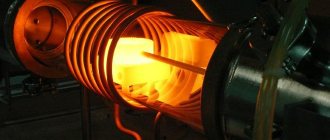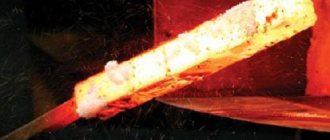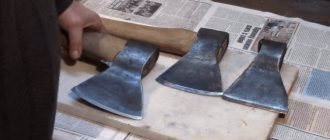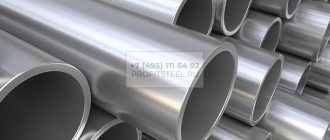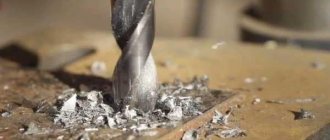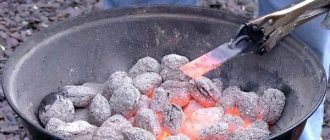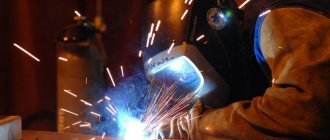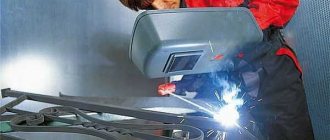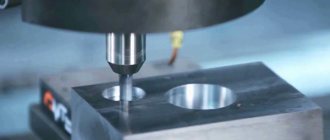Features of 9ХС steel
In the manufacture of various construction tools, special steel 9ХС is used. Products made from such metal will be distinguished by maximum strength, reliability and durability. Today we will talk about the features of this material, its advantages and disadvantages.
Methods for hardening metal at home
To harden metal at home, you will need a heat source and a container of coolant. The heat source can be an open fire from a fire, a gas burner, or a specially shaped electric oven (muffle furnace). The bath or container must be deep enough to completely immerse the part inside it.
Hardening on an open fire
The work is performed in the following sequence:
The meaning of metal color when hardening over an open fire
- Make a fire and wait for a large formation of burning coals;
- Pour oil into one container and water into another;
- When the flame reaches a bright crimson color, metal objects that require hardening are laid out on the coals;
- Using the heating table by color, monitor the state of metal heating;
- Once the required temperature is reached, the workpieces are removed using pliers and quickly lowered into the liquid;
- The optimal cooling mode is at intervals of three seconds, with a gradual increase in the time interval;
- When the metal has lost its color, continue to cool it with water.
Hardening in a muffle furnace
A muffle furnace is an electric heating device that resembles a tunnel, around which there is a nichrome electric spiral. The entire structure is coated with refractory clay, the rear end of the tunnel is tightly closed, the front end has a door through which the necessary workpieces can be placed inside the furnace. It is advisable to equip the door with a viewing window made of fireproof glass (to monitor the heating process of the workpiece).
After the metal reaches the required temperature, the rest of the cooling process occurs as described in the section: “Hardening over an open fire.”
Advantages and disadvantages
Metal 9ХС has a number of advantages.
- Unique technical characteristics . This metal is considered quite durable. It produces wear-resistant products that are practically not subject to mechanical stress; they are very resistant to bending and torsion. Even with constant use, they will not become deformed. In addition, cracks and other small defects practically do not form on their surface.
- Increased hardness . It is achieved after annealing. Also, after this procedure, the material becomes absolutely susceptible to calcination.
- Corrosion protection. This steel contains chromium, which protects the material from the negative effects of water.
- Hardness _ Tools made from such steel can easily cut other metals and dense wood.
- Same carbide distribution. This provides advantages when using this metal in the manufacture of thread-cutting devices that have a fine thread pitch.
In addition, it can be noted that the metal is characterized by increased hardenability and elasticity. It can hold an edge for a long time.
But 9ХС grade steel also has some disadvantages.
- Appearance . This metal will not shine; a peculiar pattern can be seen on its surface.
- Relatively high cost . Products made from this metal are produced by hand forging, which is why their price is quite high.
- Difficulty of processing . Even small errors in the manufacture of such steel can lead to a decrease in its quality. It behaves rather capriciously during heat treatment and sharpening.
- Loses its properties at elevated temperatures. When heated above 200 degrees, the cutting qualities of the tools are primarily reduced. It should also be noted that this variety is not suitable for the production of welded structures. During heat treatment, the material will require compliance with a specific optimal temperature regime.
- Care requirements. Chrome and silicon will not fully protect steel, so you will need to carefully wipe and dry tools after contact with water. Otherwise, over time it will begin to rust.
Alloy steel cutting tools
In the production of cutting tools, a small number of grades of alloy steels with a low content of alloying elements are used. Of these, the main ones are 9ХС, ХВГ, 95ХГСВФ and Х6ВФ (the last two brands are new and are not included in GOST 5950-51). The chemical composition of steels is shown in the table.
Chemical composition of steels
| steel grade | WITH | Mn | Si | Gr | W | V |
| 9ХС | 0.85 – 0.95 | 0.30 – 0.60 | 1.20 – 1.60 | 0.95 – 1.25 | – | – |
| HVG | 0,90 – 1,05 | 0,80 – 1,10 | 0,15 – 0,35 | 0,90 – 1,20 | 1,2 – 1,6 | – |
| 95ХГСВФ | 0,95 – 1,05 | 0,70 – 1,00 | 0,65 – 1,00 | 0,60 – 1,00 | 0,7 – 1,0 | 0,05 |
| Х6ВФ | 1,00 – 1,15 | 0,45 | 0,35 | 5,50 – 7,00 | 1,1 – 1,5 | 0,15 |
Steel grade 9ХС
Steel grade 9ХС is the most common in the production of cutting tools. It has a number of advantages compared to carbon steel. The best hardenability and hardenability of 9ХС steel allows cooling after heating for quenching in oil, which sharply reduces deformation and warping of the hardened tool
For shaped tools that are not subject to profile grinding, it is important to keep the dimensions, for example, the pitch and shape of the thread profile for taps and round dies, constant during hardening. Steel 9ХС is one of the low-deformation alloy steels. 9ХС steel ensures a uniform distribution of carbides, so it is advisable to use it for tools with thin cutting elements located not only on the periphery (for example, for taps, small drills, reamers), but especially closer to the core (for example, for round dies)
The presence of a successful combination of alloying elements (mainly silicon, chromium, manganese), as well as the uniform distribution of carbides, increases the red hardness of 9XC to approximately 250e. However, along with these advantages, 9ХС steel also has disadvantages:
9ХС steel ensures a uniform distribution of carbides, so it is advisable to use it for tools with thin cutting elements located not only on the periphery (for example, for taps, small drills, reamers), but especially closer to the core (for example, for round dies). The presence of a successful combination of alloying elements (mainly silicon, chromium, manganese), as well as the uniform distribution of carbides, increases the red hardness of 9XC to approximately 250e. However, along with these advantages, 9ХС steel also has disadvantages:
- higher hardness in the annealed state (HB 217-235);
- reduced machinability and deterioration in the quality of the machined surface due to nadir, especially when cutting threads and backing;
- increased sensitivity to decarburization, which negatively affects the hardness in thin places of the cutting part of the tools.
The increase in annealed hardness and sensitivity to decarburization is associated with the presence of increased silicon content. But, on the other hand, silicon has a significant effect on increasing red hardness.
Steel grade HVG
Steel grade HVG, compared to carbon steel, has good hardenability, smaller volumetric changes, and, consequently, significant stability in terms of maintaining the dimensions of the tool during hardening. A major disadvantage of HVG steel is its increased sensitivity to the formation of a carbide network, which leads to chipping of the cutting edges of the tool. For this reason, HVG steel is not recommended for use in tools operating in harsh conditions. Until recently, due to the shortage of high-speed steel, it was used mainly for the manufacture of broaches as a substitute for high-speed steel. In terms of redness and wear resistance, HVG steel is significantly inferior to high-speed steel grades and therefore broaches made from it have low durability (3-4 times lower compared to broaches made from P18 steel and 1.2 times lower compared to broaches made from P9 steel).
Steel grade 95ХГСВФ
Steel grade 95KhGSSVF has lower hardness after annealing and less tendency to decarburization compared to steel 9KhS. In terms of red resistance and carbide heterogeneity, it is better than HVG steel. In addition, it has greater hardenability. Round dies made from this steel showed greater durability compared to dies made from 9ХС steel.
Steel grade X6VF
Kh6VF steel has high hardenability and hardenability and significant wear resistance." This steel is recommended for hacksaw blades, rollers for thread rolling, etc.
Main characteristics
The main characteristics of this steel can be found in GOST 5950-2000 and GOST 2590-2006. First, we will analyze the chemical composition of this metal. It includes the following components:
Chromium in the metal provides, among other things, increased hardness and strength. It is also responsible for the corrosion resistance of the material. Silicon , has the same property . Due to it, the strength of the steel increases, but at the same time the toughness and ductility decrease.
Chemical composition
To create 9ХС steel, 13 substances are used, the combination of which in the right quantities results in qualitatively better physical, mechanical and operational characteristics.
Here are the components that make up 9ХС steel:
- iron (Fe) – 94%;
- silicon (Si) – up to 1.6%, but not less than 0.9%;
- chromium (Cr) – up to 1.25%, but not less than 0.95%;
- carbon (C) – 0.9%;
- manganese (Mn) – up to 0.6%;
- nickel (Ni) – 0.35%;
- copper (Cu) – 0.3%;
- molybdenum (Mo) – 0.2%;
- tungsten (W) – 0.2%;
- vanadium (V) – 0.15%;
- sulfur (S) – 0.03%
- phosphorus (P) – 0.03%;
- titanium (Ti) – less than 0.03%.
Percentages may vary slightly among different manufacturers. Deviations should not exceed 1/10 of a percent, otherwise the properties of the resulting alloy may differ.
Analogs
There are various analogues of this steel.
- HVG . This domestic substitute includes tungsten, chromium and manganese. It differs from 9ХВ steel in its increased carbon content. This material is not used for welded structures.
- HVSG . This domestic analogue is a deep calcination steel. It has increased strength and hardness.
- 90CrSi5 . This foreign substitute is alloy tool steel. It is produced in Germany.
It should be noted that the replacement of HVSG and HVG has a higher manganese content compared to 9ХС. This increases the metal's tendency to deform. All analogues are created in the same way, but their chemical composition may change.
Structural transformations during heat treatment.
We subject the steel to incomplete hardening and heat it until austenite and secondary cementite are formed.
Next, we maintain it at this temperature (840 ºС) to obtain homogeneous austenite. Subsequent cooling in oil at a rate greater than Vcrit (lower cooling rate at which austenite turns into martensite) ensures the production of fine-grained martensite.
Let us consider the transformation in oil that occurs in 9ХС steel upon heating the initial equilibrium structure F+C. In practice, at normal heating rates (in an electric furnace) for hardening, pearlite retains its lamellar or granular structure up to the Ac1 temperature (770 ºС for 9ХС steel). At temperature Ac1 in steel, pearlite transforms into austenite. Austenite crystals (grains) nucleate mainly at the boundaries of the ferrite and cementite phases. The formation of austenite grains occurs at a faster rate than the dissolution of pearlite cementite, therefore it is necessary to hold the steel at the quenching temperature to completely dissolve cementite and obtain homogeneous austenite.
Changes in steel structure during oil quenching
During continuous cooling in steel with Vcool > Vcrit, austenite transforms into martensite. Martensitic transformation develops in steel at a high speed (1000-7000 m/s) in the temperature range Mn...Mk. It is necessary to take into account that with an increase in the carbon content in steel, the temperatures Mn and Mk decrease (points Mn and Mk change their position on the graph). The introduction of alloying elements also changes the position of points Mn and Mk. For example, the introduction of silicon and chromium increases them. As a result of hardening of 9ХС steel, its structure has
except martensite and a certain amount of retained austenite (6-8%).
The formation of martensite as a result of hardening leads to high residual stresses, increased hardness and strength, but at the same time the tendency to brittle fracture increases, which requires additional subsequent tempering.
Tempering is the heating of hardened steels to temperatures not exceeding Ac1
During vacation, several processes occur. The main one is the decomposition of martensite, which consists of the release of carbon in the form of carbides. In addition, retained austenite decomposes, carbide transformation and coagulation of carbides occur, imperfections in the crystalline structure of the solid solution and residual stresses are reduced.
Let us consider transformations in hardened steel during tempering. The first transformation during tempering develops in the range of 80.200ºС and leads to the formation of a tempered martensite structure. As a result, the specific volume of martensite decreases and the residual stresses decrease. The second transformation during tempering develops in the temperature range of 200.260 o C and consists of the following stages:
1) transformation of retained austenite into tempered martensite;
2) decomposition of tempered martensite
3) reduction of residual stresses;
4) some increase in volume associated with the transition A rest
M otp.
The third transformation during tempering develops in the range of 300.400ºС. This completes the decomposition of tempered martensite and the process of carbide formation. A ferrite-carbide mixture is formed, and residual stresses are significantly reduced.
The structure of steel after low tempering (up to 250 C) is called tempered martensite; steel structure after an average tempering of 350.500ºС – troostite tempering; after a high tempering of 500.600 ºС – tempering with sorbitol.
In 9XC steel, after incomplete quenching in oil and low tempering at 170ºC, a tempered martensite structure is formed.
Steel 9ХС. Basic data
GOST 5950-73. Tool alloy steels.
Purpose: drills, reamers, taps, dies, combs, cutters, machine dies, stamps for cold work. Critical parts, the material of which must have increased wear resistance, fatigue strength during bending, torsion, contact loading, as well as elastic properties.
Application
9ХС grade steel can be used in the manufacture of a wide variety of devices. Most often it is used to create sharp and reliable knives and blades. It can also be perfect for the production of cutting parts for tools, including axes.
Knives and blades made from this metal are perfect for hunting and fishing. They are often taken for hiking trips.
They easily tolerate the effects of unfavorable environmental conditions. Such knives can withstand strong impacts and twisting. At the same time, they will retain excellent cutting properties for a long time. All of them are made by hand. Sometimes these cutting tools are also used for the needs of the food industry.
Sometimes 9ХС steel is used in the manufacture of various drills. But at the same time, they can only be used for working with soft materials, most often with wood of various species. Cylindrical reamers are also produced from it. They are used to improve the dimensional accuracy of holes and to remove roughness.
Alloy Use
The use of 9ХС occurs in the following cases:
- Making drills. But they can only be used for drilling holes on soft objects, mainly wood. Since the tool reacts negatively to high rotation speeds and overheating, it is recommended to adjust the speed when working with a soft structure.
- Cylindrical reamers. They are used to improve the accuracy of hole sizes and remove roughness. The device can be used to process vents in cast iron, alloys with medium hardness, and when working with non-ferrous iron.
- Taps. They are necessary for cutting internal threads, and are presented in the form of a screw with straight or helical grooves. When working, it is recommended to protect the product from intense loads.
- Stamps for cold work. Their use is common in factories for stamping finished products.
All actions with this material must be carried out strictly according to the rules. Otherwise, the product will lose all its positive qualities.
Heat treatment and sharpening
There are certain requirements for heat treatment of steel of this grade that must be observed. A preliminary analysis and x-ray of the structure are performed. This will allow timely identification of all defects present on the surface. At this stage, the hardness of the alloy is monitored. To properly harden the material, it will be necessary to maintain the recommended temperature.
The heat treatment itself occurs by heating the metal and then cooling it. Most often it is carried out either at the intermediate or at the final stage of manufacturing. It should be remembered that it directly affects the strength of steel. Cooling of the metal, as a rule, occurs in a special oil.
Most often, this hardening is carried out in special electric furnaces equipped with a sealed casing. As a rule, such equipment is equipped with a special system for adjusting and maintaining optimal temperature conditions. During processing, the hardness of the steel is periodically checked.
Sharpening the material allows you to remove a small layer from it and give it the desired shape.
After such a procedure, small marks will remain on the metal surface. As a rule, after this the product is also polished and fine-tuned. They are carried out in order to give it its final shape, the sharpening angle.
Most often, a variety of abrasives are used for sharpening. This procedure is carried out not only during the steel production process, but also in the future as the products are used.
After all the processing, the steel is produced in the form of large sheets. They may vary depending on length and thickness.
Source
Explanation of markings
For marking steels and other materials, certain standards are being developed, the use of which makes it possible to simplify the process of determining the chemical composition. This steel is deciphered as follows:
- In the instrumental group, the first digit indicates the carbon content (in tenths of a percent), that is, in this case, 0.9% carbon. This element is considered the main one, as it determines the characteristics of the crystal lattice, hardness, strength, fragility and other qualities.
- As previously noted, the steel was alloyed to change some performance characteristics. Chromium and silicon, of which no more than 1.5%, were used as alloying materials.
In addition to the above elements, the composition contains many others that are an integral part of steels.
https://youtube.com/watch?v=6x8Jxd0R72M
This is interesting: Steel grade 30KhGSA - characteristics, explanation, application
